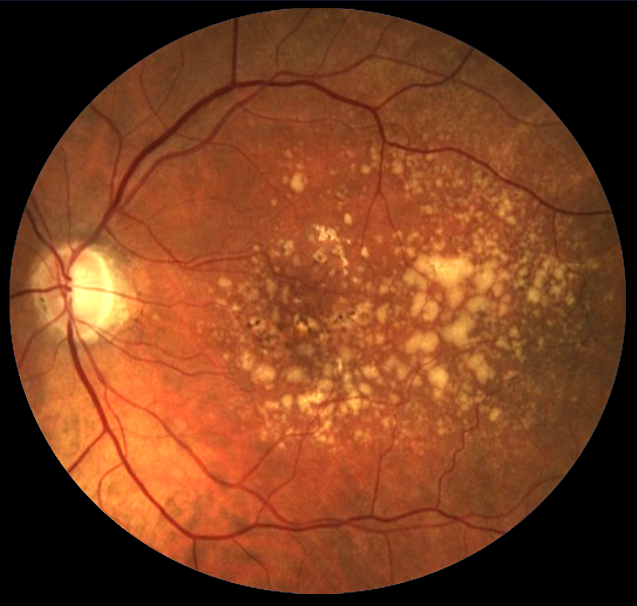 |
| The second eye to be treated in AMD patients was found to have a higher BCVA, likely because the eye was being regularly examined throughout treatment of the first eye. Photo: NEI. Click image to enlarge. |
Age-related macular degeneration (AMD) is a bilateral disease, and most patients develop the condition in the fellow eye after two to six years. Researchers recently analyzed data from the Swedish Macular Registry on first- and second-eye treatment and found that visual acuity was higher in the second eye.
In the observational study, 28,670 treatment-naïve patients underwent unilateral AMD treatment, and 18% later required bilateral treatment (average age 78, 69% female). Mean treatment duration of the first eye before the fellow eye was diagnosed was 19 months; the first eye received a mean number of 8.9 injections. The authors noted that in the earliest period of the study (2010-2013), treat-and-extend hadn’t yet been introduced.
Second-eye BCVA was higher when treatment in that eye began than when treatment started in the first eye. Second-eye BCVA was also higher at the start of treatment when the first eye was still undergoing treatment. The researchers pointed out, “This indicates a greater probability of early diagnosis of the second eye if the patient’s first eye is still being treated and thus regularly examined.”
They also wrote that patients tended to seek medical attention when they experienced symptoms such as metamorphopsia, reading difficulties and impaired visual acuity. However, many had difficulty remembering when symptoms began or interpreting their visual changes. Subtle, monocular and varying changes were particularly difficult for older patients to recall, even with at-home tests and when the other eye was being treated, the researchers said. They also noted that Swedish patients’ trust in their healthcare system may have prompted patients to seek treatment earlier.
The authors stressed the importance of examining both eyes. They wrote that in an attempt to simplify the clinic visit, most of the focus is devoted to only the eye receiving treatment. “This may lead to the risk of missing the development of a macular lesion in the second eye,” the authors wrote.
Adrian ML, Schroeder M, Westborg I. What about the fellow eye in treatment of neovascular age-related macular degeneration? Analysis of data from the Swedish macular register. Acta Ophthalmol. January 22, 2022. [Epub ahead of print]. |

